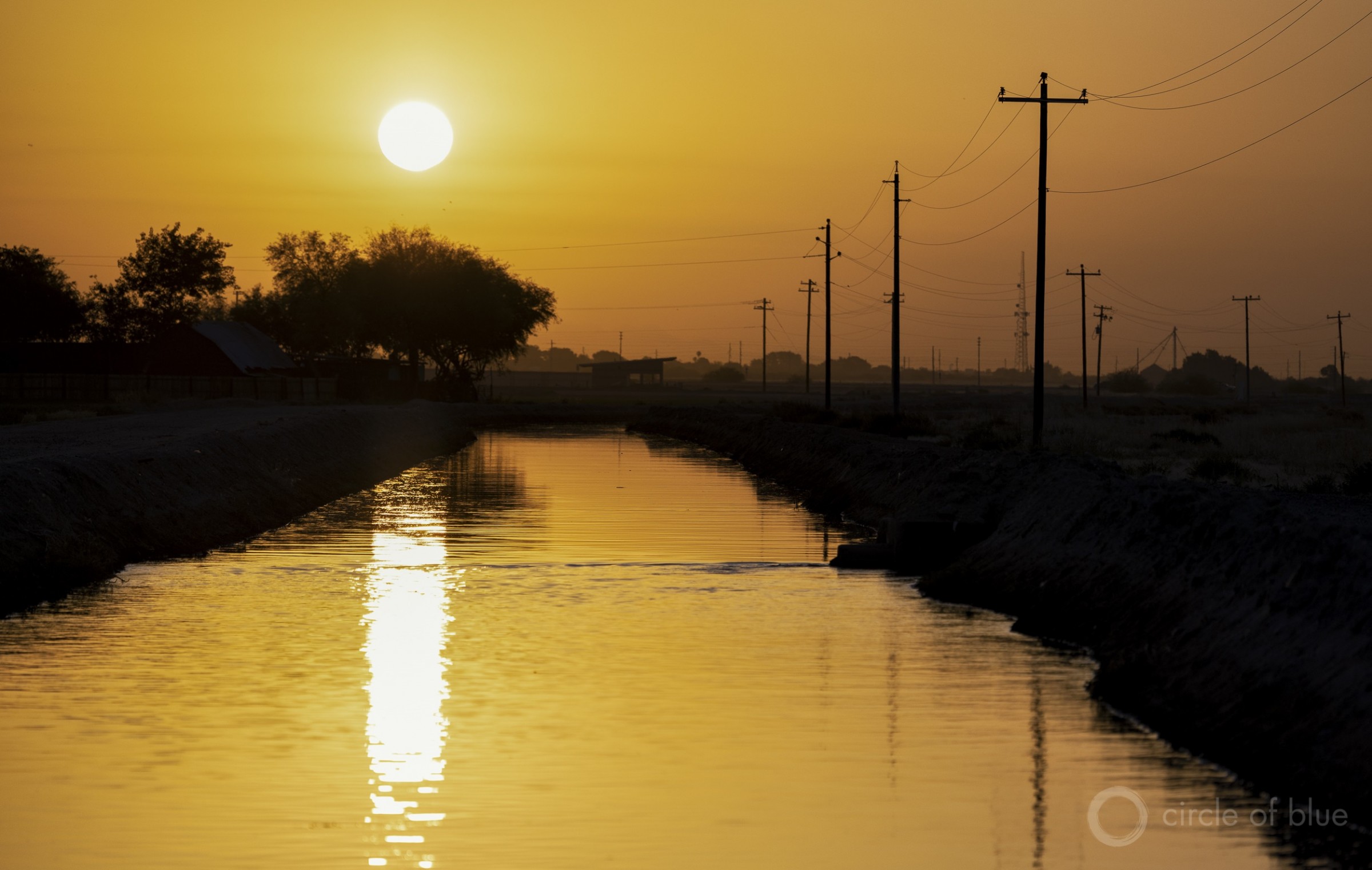The Stream, December 28, 2022: Mercury Pollution of Waterways Spoils Bolivia’s Gold Mining Boom

The sun illuminates a canal in Buckeye, Arizona. Photo © J. Carl Ganter/Circle of Blue
YOUR GLOBAL RUNDOWN
- Activists call on Bolivia to regulate the mining industry’s use of mercury, which continues to pollute biodiverse watersheds, rivers, and drinking water.
- The San Carlos Apache Tribe announces a tentative one-year deal to provide water to an unincorporated residential community outside of Scottsdale, Arizona.
- Hundreds of Chinese migrants, seeking refuge in the United States, risk their lives to cross the Darién Gap’s watershed at the Columbia-Panama border.
- A nationwide analysis of American public drinking water found heightened concentrations of arsenic and uranium in communities with higher Black, Latino, and/or Indigenous populations.
Teff, a crop native to Ethiopia, is emerging as a water-smart alternative in Nevada’s high desert.
“The big issue here for farmers is that they face an uncertain future in terms of water availability.” — Dr. John Cushman, a biochemist at the University of Nevada, Reno.
Water scarcity has made teff, a grain eaten in abundance in Ethiopia, a lucrative option for farmers east of the Sierra Nevada mountains. In this arid region, annual rainfall rarely exceeds single-digit inches, and water for irrigation remains one of farmers’ largest expenses.
But teff is resilient to periods of drought, Ambrook Research reports, falling dormant — though not dying — when water is scarce. The crop also requires less fertilizer, and its profit margins usually settle around $1,000 per acre. The grain itself is gluten-free, nutrient-rich, and a particularly healthy choice for diabetics.
Still, despite teff’s durability, unseasonal temperatures and increasing water costs present uncertainty for farmers, Ambrook reports. Further research into innovative growing methods continues in Nevada, and arid Western states at large.
— Christian Thorsberg, Interim Stream Editor
Recent WaterNews from Circle of Blue
- The Year in Water, 2022 — “Sharpening the Shark’s Teeth,” a roundup of Circle of Blue’s reporting and investigations, from climate change to public health to ecosystems.
- Federal Water Tap, December 26 — Water Spending Woven into Budget Deal.
The Lead
Bolivia’s mining business is booming. Gold was the country’s top export in 2021 — worth $2.5 billion — doubling its 2020 numbers, Yale Environment 360 reports. But the precious metal’s mining process is largely unregulated, especially in regard to the industry’s usage of mercury.
Mercury is currently essential to the extraction of gold from riverbeds. The toxic chemical is mixed with the metal-rich soil to create a liquid slurry, from which pure gold is removed. But the leftover process water and fumes remain infused with mercury, which is being discovered in both water systems and people in Bolivia’s downstream communities.
Samples from multiple Indigenous communities living near the Bolivian Amazon revealed levels of mercury well above what is considered safe — and that number, 2 parts per million, is disputed by many scientists who say that no amount of mercury is safe. Research and the creation of health networks that would link mercury poisoning and tribes’ health to the mining projects are still ongoing, but some people, according to Yale 360, have already complained of negative health effects.
As concerns over mercury levels grow, the communities’ reliance on fishing — often at the center of culture and economy — has been placed into question, without resolution. The Bolivian government said it would introduce mercury regulation plans in July 2022, after the United Nations sent a “Letter of Allegation.” These plans have yet to appear.
This Week’s Top Water Stories, Told In Numbers
740
Approximate number of homes in Rio Verde Foothills — an unincorporated, age-restricted residential community outside of Scottsdale — that will have their water supplied by the San Carlos Apache Tribe. The community had previously received its water from commercial companies, which drew from Scottsdale water reserves — a process the city announced it would no longer facilitate. If the one-year deal is approved, the tribe will lease up to 65 million gallons of water in 2023, Native News Online reports.
17 percent
More uranium than the national average found in the drinking water of communities that have at least 10 percent more Hispanic and Latino people than white people. A recent Nature Communications study shows a nationwide trend: uranium and arsenic contamination is more prevalent in the drinking water of communities with more Black, Hispanic, Latino, and/or Indigenous residents.
On the Radar
In increasing numbers, Chinese citizens are risking their lives to cross the perilous Darién Gap — a mountainous, tropical region marked by the Atrato River and its expansive watershed — at the Columbia-Panama border. The hundreds of people who have recently made the journey — from China to Ecuador, through Central America, and eventually reaching the United States — “are fleeing China in search of a safer, brighter future, which they term ‘runology,’” reports independent journalist Yingyu Alicia Chen.
More Water News
Salmon People: A new documentary from ProPublica and Oregon Public Broadcasting features the Wy-Kan-Ush-Pum, the Salmon People, who live with the Columbia River in the Pacific Northwest. Dams, broken treaty rights, and climate change have hindered the tribes’ rights to fish, and threatened the region’s salmon population. Still, these communities are resilient and solution-oriented in their efforts to revitalize numbers of the sacred fish.
Glaciers: The year 2025 will be recognized as the International Year of Glaciers’ Preservation, the United Nations General Assembly declared.
Christian Thorsberg is an environmental writer from Chicago. He is passionate about climate and cultural phenomena that often appear slow or invisible, and he examines these themes in his journalism, poetry, and fiction.





Leave a Reply
Want to join the discussion?Feel free to contribute!